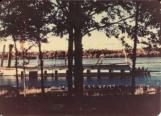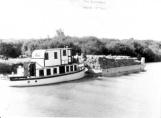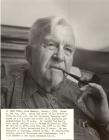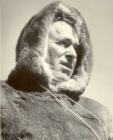14
The river drives of The Pas Lumber Company continued until the winter of 1956-57. Economics and a scarcity of large timber led to the closure of the lumber mill in 1957 and the planer mill in 1958. A significant chapter in the history of The Pas came to a close. The future would bring more forest industry to the area, but the era of log drives on the Saskatchewan River was at a close.16
Sternwheeler David N. Winton as a derelict near the bank of the Saskatchewan River.1960
The Pas, Manitoba, Canada

18
TrappingThroughout the previous century, trapping has continued as a means of livelihood for many in the rich, fur-producing areas of the Saskatchewan River delta. Fred Kerr of Kerr's Furs bought many pelts throughout the north, traveling by canoe in warmer months and by train during the other times.
20
The Last FrontiersmanTom Lamb was a true northern pioneer and frontiersman. He was born at Grand Rapids in 1898, the second of two children of T. H. P. Lamb. (The THP actually stood for Thomas Henry Peacock, but most knew him as Ten Horse Power Lamb.)
Tom moved with his family to Moose Lake when he was two years old, and was raised among the Moose Lake Indians who lived in the area and traded at the Lamb store. As a young teenager, Tom was leading freight convoys through the vast northern wilderness.
21
Tom Lamb freighting from The Pas with ten canoes to Reindeer Lake, paddling all the way.1925
The Pas, Manitoba, Canada

22
Tom Lamb went on to become a trader, freighter, commercial fisherman, muskrat rancher, cattle rancher and legendary bush pilot. As a pioneer aviator, Tom acquired his first plane in 1933, and in 1935 he founded Lambair, a business that operated 27 airplanes and helicopters throughout Canada's north.Tom and his wife Margaret raised three daughters and six sons. All of the boys became licensed pilots. Tom passed away in 1969. A Leo Mol bronze statue pays tribute to Tom Lamb in the Mol Sculpture Gardens at Assiniboine Park in Winnipeg, and at The Pas Airport. Tom was made a Manitoba Golden Boy and was also given an Honorary L.L.B. by the University of Manitoba.
A great linguist and traveler, he will always be remembered as a legendary character of This Great North Land that he loved so well.
23
The boat 'Skippy L' pushes a barge with load of hay hay from the Summerberry River to Moose Lake.1940
Summerberry River, Manitoba, Canada

24
The Skippy LOne of the last wooden-hulled boats of the Saskatchewan River, the Skippy L was built for Tom Lamb by the Lyons Canoe Company of The Pas in 1934-35. 45 feet in length, with a beam of 13 feet, the Skippy L continued in the service of Thomas Lamb Enterprises until the early 1980s. The tug boat was used to haul supplies to the Lamb store at Moose Lake, to move trappers and their outfits to the Lamb muskrat ranch, to haul feed to thier cattle ranch, and to barge freight to points between Grand Rapids and Cumberland House.
Tom had intended to name the boat 'The Enterprise', but found that a Prince Albert boat was already registered under that name. Instead he christened the boat with the nickname of his daughter Phyllis.
Upon her retirement from service, the Skippy L was given to The Pas History and Heritage Society, and is on display in Devon Park. On June 21, 1989, the Skippy L became a Provincial Designated Heritage Object, the first such designation in the province of Manitoba.
26
Commercial FishingCommercial fishing has been carried out on the lower Saskatchewan River since shortly after the province of Manitoba took over the management of natural resouces from the federal government in 1930.
Most of the commercial fishing is carried out on Cedar Lake, the last segment of the river system before it enters Lake Winnipeg at Grand Rapids. However, there are also commercial fishing operations on the river itself. These are the only commercial fishing licences operated on a river in Manitoba.
The primary fish species in the commercial fishery are walleye (pickerel), pike (jackfish), and whitefish, although there are at least seven other species of fish with commercial value.
27
AgricultureLouis de la Corne sowed the first grain grown in what is now western Canada near Fort Paskoyac that was near the junction of the Saskatchewan and Pasquia Rivers in 1753.
For the next 150 years however, agriculture was limited to small-scale gardening and grain growing at the small settlements, trading posts and missions of the area. Large-scale agricultural development did not follow until the coming of the railroad in 1908, after which the fertile land of the Carrot River Valley west of The Pas was developed.
Early attempts at farming this land were often disrupted by frequent flooding as water from the North Saskatchewan back-flowed into the Carrot and Pasquia Rivers. The Manitoba Department of Mines and Resources subsequently constructed a series of dykes in the Carrot River Valley during the 1940s to prevent flooding of the farmland west of The Pas. Once the threat of flooding was mitigated by engineered controls, the Carrot River Valley flourished as a productive northern agricultural centre.



